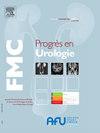Comment optimiser les résultats fonctionnels d’une néo-vessie iléale chez la femme ?
Q4 Medicine
引用次数: 0
Abstract
La cystectomie totale chez la femme est essentiellement réalisée, tout comme pour l’homme, dans le cadre de la prise en charge d’une tumeur vésicale infiltrant le muscle. D’autres indications de la cystectomie sont plus rares, telles que les tumeurs gynécologiques envahissant la vessie, et les vessies neurologiques. Historiquement, l’urétrectomie faisait partie du geste chirurgical, vu le risque de récidive urétrale, la facilité de l’ablation de l’urètre féminin, et la classique idée que l’urètre féminin après cystectomie est dépourvu de ses fonctions. Une meilleure compréhension de l’anatomie fonctionnelle de l’urètre féminin s’est accompagnée d’une évolution des techniques chirurgicales, rendant possible d’envisager une néo-vessie iléale. La principale contre-indication d’ordre oncologique est l’envahissement de l’urètre et du col vésical à l’examen extemporané peropératoire. Le pronostic fonctionnel et la continence postopératoire dépendent, en plus des critères rigoureux de sélection préopératoires, de la technique chirurgicale.
As part of the treatments’ armamentarium of muscle invasive bladder cancer, radical cystectomy is considered as a therapeutic option, both in men and in women. Other scarcer indications for cystectomy are possible and include but not limited to gynecological tumors with bladder invasion and neurogenic bladders. Historically, urethrectomy was prosaically performed during cystectomy owing to the evident risk of urethral recurrence of urothelial carcinoma after cystectomy, the simplicity of the surgical technique in women and the general belief in the unavailing function of female urethra after cystectomy. A better understanding of the functional anatomy of the female urethra has been escorted throughout the years by the fruition of new surgical techniques, leading to the ultimate possibility of ileal neo-bladder creation. The main intraoperative contraindication is the tumor invasion of the urethra and the bladder neck in frozen section examination. Postoperative urinary continence together with the functional outcome post-radical cystectomy in women depend, in addition to a meticulous preoperative selection criteria, on the surgical technique.
如何优化女性非点滴性膀胱新生的功能效果?
与男性一样,女性的全腹腔切除术主要是为了治疗渗入肌肉的膀胱肿瘤。膀胱切除术的其他适应症比较罕见,如妇科肿瘤侵入膀胱和神经膀胱。从历史上看,尿道切除术是一种外科手术,因为尿道复发的风险,切除女性尿道很容易,而且传统上认为女性尿道在膀胱切除术后没有功能。随着手术技术的发展,对女性尿道功能解剖学的更好理解使非特异性膀胱新生成为可能。主要的肿瘤学禁忌症是尿道和膀胱过度扩张。功能预后和术后控制除了严格的术前选择标准外,还取决于手术技术。作为肌肉侵袭性膀胱癌治疗武库的一部分,根治性膀胱癌被认为是一种治疗选择,无论是男性还是女性。膀胱切除术的其他划痕适应症是可能的,包括但不限于伴有膀胱侵入和神经源性膀胱的妇科肿瘤。从历史上看,由于子宫切除术后尿道癌复发的明显风险、女性手术技术的简单性以及人们普遍认为女性子宫切除术后尿道功能不正常,尿道切除术通常在子宫切除术期间进行。多年来,新的外科技术的成果一直伴随着对女性尿道功能解剖学的更好理解,导致了非法新生膀胱产生的最终可能性。主要的术后禁忌症是肿瘤侵入尿道和膀胱颈的冷冻剖面检查。女性术后尿失禁以及根治性膀胱切除术后的功能结果取决于手术技术,以及术前选择标准。
本文章由计算机程序翻译,如有差异,请以英文原文为准。
求助全文
约1分钟内获得全文
求助全文

 求助内容:
求助内容: 应助结果提醒方式:
应助结果提醒方式:


